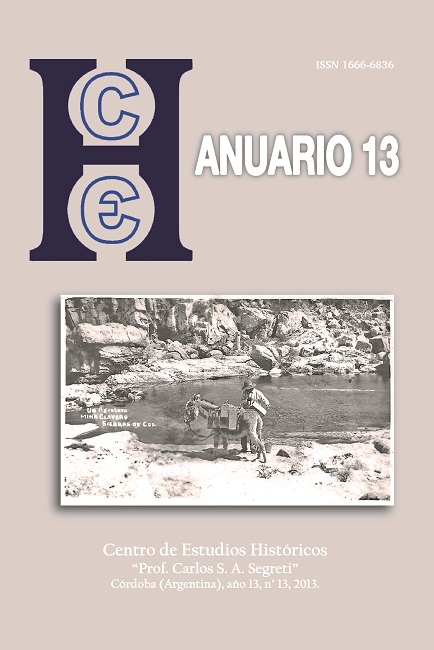From the battlefield to the screen. The Women of the Mexican Revolution in Mexican Cinema: The Case of "La Negra Angustias"
DOI:
https://doi.org/10.52885/2683-9164.v0.n13.22172Keywords:
revolution, movies, women, AngustiasAbstract
Mexican movies of the Golden Age made popular the image of women who participated in the Mexican Revolution with the figure of “Adelita”; a hackneyed and repetitive representation of values such as bravery, abnegation, marriage and motherhood. Nevertheless, there are few excpetions, like La negra Angustias, directed by Matilde Landeta in 1949. Angutias, the protagonist, different as she was a coronel in one of Zapata’s troops with ideals such as justice and liberty for the poor. She was also reluctant to marry and to accept the oppression of any man, showing behavior conventionally considered to be masculine. Regarding the cinematographic environment, I rescue the vision of a woman director, a pioneer in Mexican movies, who went against the flow of female stereotypes with the intention of redressing the role of women in Mexican in History.
Downloads
References
ARROYO Claudia, “Entre el amor y la lucha armada”, ORTIZ MONASTERIO Pablo, Cine y Revolución. La Revolución Mexicana vista a través del cine, México, Consejo Nacional para la Cultura y las Artes, 2010.
AYALA BLANCO Jorge, “Feminismus. Matilde Landeta, nosotros te amamos”, Siempre!, núm. 1152, 23 de julio de 1975.
AZUELA Mariano, Los de abajo, México, Fondo de Cultura Económica, 1995.
BURTON Julianne, Matilde Landeta, hija de la Revolución, México, Consejo Nacional para la Cultura y las Artes/Instituto Mexicano de Cinematografía, 2002.
CAMARERO Gloria, DE LAS HERAS Beatriz y DE CRUZ Vanessa, “La Historia en la pantalla”, CAMARERO Gloria [et. al.], Una ventana indiscreta. La historia desde el cine, Madrid, Ediciones JC. Rodríguez/Instituto de Cultura y Tecnología/Cátedra de Estudios Portugueses “Luis de Camoes”/Universidad Carlos III de Madrid, 2008.
CORIA José Felipe, “Y ahora doña Matilde”, El Financiero, 4 de febrero de 1999.
GARCÍA RIERA Emilio, Historia Documental del Cine Mexicano, vol. 5,México, Universidad de Guadalajara,1993.
HERSHFIELD Joanne, “La mitad de la pantalla: la mujer en el cine mexicano de la época de oro”, GARCÍA Gustavo y MACIEL David R., (comp.), El cine mexicano a través de la crítica, México, Universidad Nacional Autónoma de México/Instituto Mexicano de la Cinematografía/Universidad Autónoma de Juárez, 2001.
HERSHFIELD Joanne y MACIEL David R , México’s Cinema. A century of film and filmmakers, Wilmington, Delaware, Scholarly Resources Books, 1999.
ÍÑIGUEZ Dalia, “Cinedalias”, Cinema Reporter, 29 de octubre de 1949.
MARTÍNEZ DE VELASCO VÉLEZ Patricia, La lucha de la mujer para llegar a ser directora de cine, Tesis para obtener el título de Licenciada en Comunicaciones, México, Universidad Iberoamericana, 1989.
MEDRANO PLATAS Alejandro, Quince Directores del Cine Mexicano, México Plaza y Valdés, 1999.
OROZ Silvia, “La mujer en el cine latinoamericano (Décadas de los años 30, 40, 50)”, XI Festival Internacional del Nuevo Cine Latinoamericano, México, Dirección General de Actividades Cinematográficas-Coordinación de Difusión Cultural/UNAM, 1990.
OROZ Silvia, Melodrama, el cine de lágrimas de América Latina, México, Río Fundo Editora LTDA, 1995.
PÉREZ MONTFORT Ricardo, Estampas de un nacionalismo popular mexicano. Ensayo sobre cultura popular y nacionalismo, México, CIESAS/Colección Miguel Othón de Mendizábal, 1994.
ROBLES Xavier, La oruga y la mariposa, los géneros dramáticos en el cine, México, Centro de Estudios Cinematográficos-Universidad Nacional Autónoma de México, 2010.
ROSENSTONE Robert A., “La historia en imágenes/la historia en palabras: reflexiones sobre la posibilidad real de llevar la historia a la pantalla”, p. 94. [En Línea] http://www.istor.cide.edu/archivos/num_20/dossier5.pdf Consulta: 24/09/2015. Texto aparecido en el “Forum” de The American Historical Review, vol. 93, núm. 5, diciembre 1988.
SALAS Elizabeth, Soldaderas en los ejércitos mexicanos, México, Ediciones Diana, 1995.
TUÑÓN Julia, Mujeres de luz y sombra en el cine mexicano. La construcción de una imagen (1939-1952),México D.F., El Colegio de México, 2008.
Downloads
Published
How to Cite
Issue
Section
License
Aquellos autores/as que tengan publicaciones con esta revista, aceptan los términos siguientes:
- Los autores/as conservarán sus derechos de autor y garantizarán a la revista el derecho de primera publicación de su obra, el cuál estará simultáneamente sujeto a una Licencia de reconocimiento de Creative Commons. Se puede compartir, copiar, distribuir, ejecutar y comunicar públicamente la obra, siempre que: a) se cite la autoría y la fuente original de su publicación (revista, editorial y URL de la obra); b) no se use para fines comerciales; c) no se altere, transforme o genere una obra derivada a partir de esta obra.
- Los autores/as podrán adoptar otros acuerdos de licencia no exclusiva de distribución de la versión de la obra publicada (p. ej.: depositarla en un archivo telemático institucional o publicarla en un volumen monográfico) siempre que se indique la publicación inicial en esta revista.
- Se permite y recomienda a los autores/as difundir su obra a través de Internet (p. ej.: en archivos telemáticos institucionales o en su página web) después del proceso de publicación, lo cual puede producir intercambios interesantes y aumentar las citas de la obra publicada. (Véase El efecto del acceso abierto).


